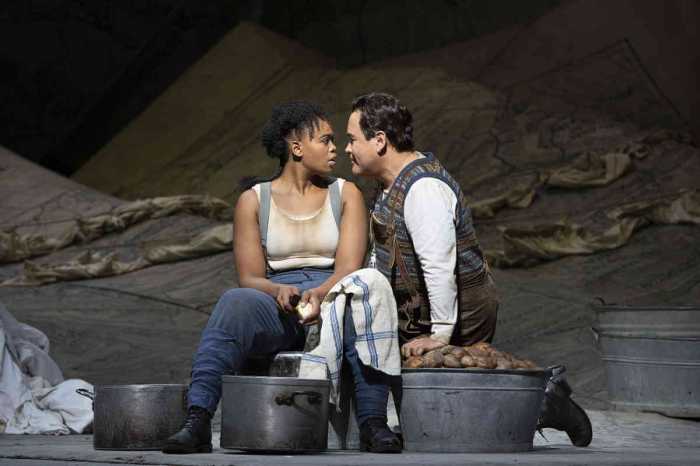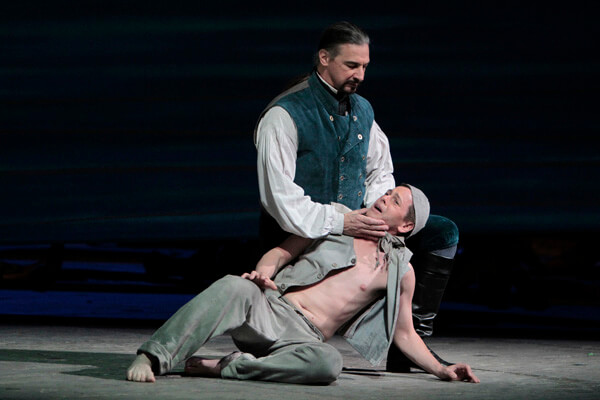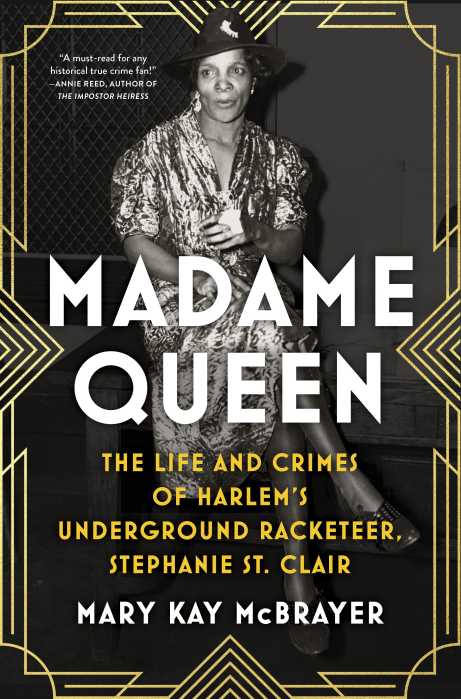Karita Mattila (standing) and Oksana Dyka in JanáÄek’s “Jenůfa.” | KEN HOWARD/ THE METROPOLITAN OPERA
ELI JACOBSON | Opera depends upon — thrives on — heightened emotions and conflicts. Tragic love affairs are great sources for oversized emotional conflicts. But dysfunctional family conflicts are another great source for melodrama, as the upcoming holiday season will undoubtedly remind us. This fall, I had the opportunity to confront several dysfunctional families in opera but also a functional lesbian family.
I saw the Metropolitan Opera’s revival of JanáÄek’s twisted family drama “Jenůfa” on Halloween night. All evening I was haunted by the ghosts of “Jenůfa” productions past. When this Olivier Tambosi staging premiered in 2003, Karita Mattila starred as Jenůfa. For this revival, the great Finnish soprano, returning to the Met after a four-year absence, moved into the role of the stepmother KostelniÄka, and proved herself a worthy successor to Leonie Rysanek, Anja Silja, and Deborah Polaski. Sadly, the rest of the cast could not compare to Mattila or their predecessors in this opera. Nor did David Robertson’s very able conducting match the idiomatic mastery of JiÅ™í BÄ•hlolávek in the 2007 revival. Tambosi’s widely traveled minimalist production has one central concept — a symbolic rock representing Jenůfa’s child emerging through the floor in Act I, looming as the elephant in the room in Act II, and smashed in pieces in Act III.
As Jenůfa, Oksana Dyka displayed a plain, hard-working stage persona and a sturdy monochromatic soprano with a piercing timbre. Dyka got the job done but lacked vocal or personal radiance. Daniel Brenna as Laca acted the role with the same awkward teddy bear manner that he brought to Alwa in “Lulu.” Brenna’s burly tenor again sounded knotty and strained — after Act II he was announced as indisposed. In Act III, Brenna mimed Laca while Garrett Sorensen sang the role from stage left. I would have enjoyed hearing Sorensen's brighter, more flowing tenor sound in the entire role. As Å teva, Joseph Kaiser was effectively shallow and spineless, though his costuming and wig should have emphasized the seducer’s superficial attractiveness. Veteran Hanna Schwarz, also returning after a long absence, made Grandmother Buryja a dominating figure while doing very little.
Twisted drama of JanáÄek’s “Jenůfa”; loving portrait of Stein, Toklas in Ricky Ian Gordon’s “27”
Initially Mattila seemed too attractive and sympathetically feminine as the KostelniÄka; she emphasized maternal warmth rather than cold severity in her relationship with Jenůfa. But in Act II when the KostelniÄka confronts Å teva, urging him to marry Jenůfa and acknowledge his illegitimate son, Mattila transformed into a creature possessed. Consumed with cold rage at Å teva’s betrayal, Mattila traced this strong woman’s breakdown that leads to infanticide with chilling detail. Mattila’s middle register sounds darker and fuller. Her free and soaring upper range is a rarely heard commodity in a role usually given to mature sopranos or mezzos in the final stages of a long career. This revival achieved emotional catharsis and tragic force only when Mattila was center stage.
The House of Atreus is perhaps the dysfunctional family that has been inspired the greatest number of artists for the longest time – more than 2,500 years. (The children of Adam and Eve – Cain and Abel – may have preceded the Atreides as the first dysfunctional family.) Last season, New Yorkers experienced a striking new production of Strauss’ “Elektra” based on the second play of the Oresteia cycle. This October 8, Teatro Grattacielo presented the New York premiere of what could be called a prequel to “Elektra” – Vittorio Gnecchi’s 1903 opera “Cassandra.”
Never heard of Gnecchi or “Cassandra?” Well the first chord of Gnecchi’s “Cassandra” sounds exactly like the “Agamemnon” chord that opens Strauss’ “Elektra.” Several other similarities have been found between the two scores. For more than 100 years, the wealthy Milanese Gnecchi has been accused of musical plagiarism or perhaps “musical telepathy.” A misguided critical backlash stalled the progress of Gnecchi’s musical career, placing “Cassandra” in unperformed obscurity.
What the musical establishment missed is that the premiere of Gnecchi’s “Cassandra” preceded Strauss’ “Elektra” by four years – “Elektra” premiered in 1909. Worse, Strauss was in possession of a presentation copy of Gnecchi’s published score around the time he started composing “Elektra” circa 1906. There are, however, more differences than similarities between the two compositions. Gnecchi’s orchestration draws from similar Wagnerian sources as Strauss’ work but is less dissonant and the vocal writing more lyrical. In fact, “Cassandra” is more reminiscent of Puccini’s “Turandot” and Zandonai’s “Francesca da Rimini” – tuneful Technicolor Italian bombast. Luigi Illica’s prolix and deliberately archaic Italian libretto (drawn from Aeschylus’ “Agamemnon”) is in two acts. King Agamennone (Agamemnon) returns from the Trojan War with the clairvoyant captive Princess Cassandra of Troy as his concubine. He faces his vengeful wife Queen Clitennestra (Clytemnestra), who abetted by her lover Egisto (Aegisthus) has murder in mind. Agamennone’s homecoming reception ends in bloodshed for both king and captive princess. This crime inspires Agamennone’s royal children Electra and Orestes to avenge their father’s murder. Cue Richard Strauss.
Teatro Grattacielo’s concert reading made a strong case that Gnecchi was a talented and forward-looking composer who got a raw deal from posterity. Maestro Israel Gursky relished the vibrant orchestral tapestry of this unfamiliar score. The well-rehearsed Teatro Grattacielo Orchestra and three borrowed choruses filled John Jay College’s Gerald W. Lynch Theater with exciting sound. The soloists were a strong team. Arnold Rawls’ beefy dramatic tenor was undaunted by the high placed declamation of Agamennone’s music. As Clitennestra, New York native Elena O’Connor, looking like the model Iman, rocked a skin-tight black leather sheath gown. O’Connor’s dusky spinto soprano with its scintillating top register also proved a knockout; let’s see and hear more of this talent soon.
In the title role, mezzo-soprano Alessandra Volpe also fielded a distinctively rich and colorful instrument and delivered Cassandra’s fateful warnings with incisive Italian diction. Lyric baritone Shea Owens sang Egisto with smooth legato, and bass-baritone Stefanos Koroneos delivered the Prologo’s music with idiomatic Italian diction and vocal intensity.
Some operatic scores are neglected for reasons of musical quality or outmoded style. “Cassandra” and its composer were the victims of critical injustice. Thanks to Teatro Grattacielo, we got to make up our own minds.
The MasterVoices 2016 Fall Gala presented the New York premiere of Ricky Ian Gordon’s one-act chamber opera “27,” which explores the Paris ménage of Gertrude Stein and Alice B. Toklas. The title refers to 27 Rue de Fleurus, the address of Stein’s salon that became the artistic center of 20th century avant garde literature, painting, and photography. Royce Vavrek’s libretto is structured as a fragmented flashback as Toklas, grieving the loss of her life partner, reflects on her domestic union with Stein that spanned two World Wars. Stein writes poetry and novels, collects paintings and painters — all the while acting as mentor/ muse/ guru to Picasso, Hemingway, F. Scott Fitzgerald, Matisse, and Man Ray. Toklas makes tea and is content to be the “little woman” to the resident genius.
Heidi Stober and Stephanie Blythe in Ricky Ian Gordon’s “27.” | ERIN BAINO
Vavrek’s depiction of Stein’s Paris salon is sentimental and simplistic with jejune stabs at intellectual humor like a collegiate skit. Stein is portrayed as a butch lesbian composite of Yoda, the meddling Dolly Levi, and bohemian eccentric Auntie Mame. Fitzgerald and Hemingway are one-note cartoons. The libretto’s repetition of gnomic short phrases is meant to evoke Stein’s abstract literary style though Vavrek explicitly avoids quoting Stein’s writing. Gordon’s busy score is an intersection of satiric cabaret and chamber opera in a lively playful fashion. His music only digs under the emotional surface in haunting love duets for Gertrude and Alice — their voices intertwine in tight madrigal-like harmonies evoking their interdependence of heart and mind.
The role of the generous, dominating Gertrude Stein was created for and by Stephanie Blythe at the 2014 world premiere in St. Louis. Blythe’s Stein is imposing but the voice and body now move with effort. At age 46, Blythe should be at her vocal peak so the shortness of breath and range afflicting her once opulent mezzo is alarming. Alice B. Toklas was portrayed movingly by soprano Heidi Stober, who isn’t naturally mousy or birdlike. Stober’s shining clarity of tone suggested Toklas’ capacity for pure devotion.
The various artists, relatives, doughboys, and hangers-on were impersonated by a talented trio of quick-change virtuosos: Theo Lebow, Tobias Greenhalgh, and Daniel Brevik. James Robinson’s intimate production inventively utilized picture frames in an unpretentious, effective manner. Artistic director Ted Sperling led the MasterVoices chorus and Orchestra of St. Luke’s in an authoritative account of the score.
“27” isn’t a profound work but, like Stein, it entertains with an open and humane spirit. Gertrude and Alice, like so many gay men and women, were obliged to leave their family homes so they could live honestly in a heteronormative society. They created a chosen family and a new society in a cosmopolitan city. Gordon’s loving portrait of two pioneering lesbians provides inspiration for today’s LGBT community, which faces a difficult four years ahead of us. Our hard-earned marriage equality rights — which Stein and Toklas enjoyed in spirit but not in law — could be in peril.




































